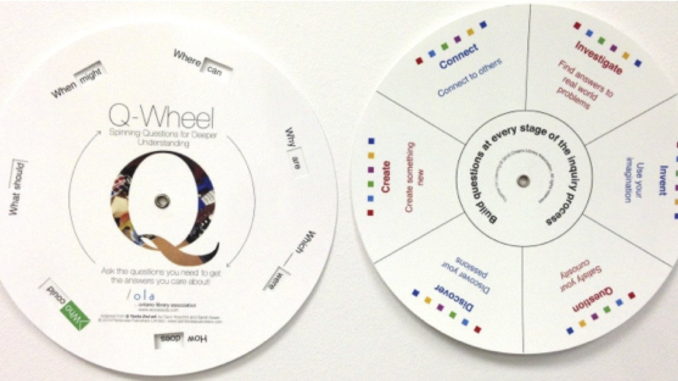
By Carol Koechlin

Questioning as a Lifelong Learning Skill
It is particularly critical for learners today to be able to generate lots of probing questions as they navigate volumes of information available on any one topic and try to determine usefulness and credibility. Questioning is the base skill that makes all thinking purposeful. Consequently intuitive questioning techniques are essential learning tools. Student initiated questions open the doors to curiosity, wonder and imagination.
If students own the question they are hooked on learning and it feels so good when they discover answers to inquiries they shaped.
Questioning as a Habit of Mind
If learners are to be successful readers, writers, researchers, innovators, makers and participants in learning communities they need to hone their questioning skills and approach learning with an inquiry stance. Questioning is not negative. Questioning helps learners to scrutinize information and ideas critically, systematically, analytically or methodically, and thus become healthy skeptics of what they read, view and listen to as well as contributors to understanding and creators of new knowledge.
Questioning as a Desire to Know
Questions are the mental hooks that capture interest, imagination, and creative spirit. If students own the question they are interested and motivated. Without student generated questions inquiry and discovery learning experiences often lack engagement and will not generate meaningful growth. The question is a catalyst for purposeful thinking and a desire to learn. Questioning nurtures intellectual curiosity which is a valued disposition for future success.
Questioning as the Catalyst for Metacognition
To become better learners, students need to be guided through the process of thinking about what they have learned and how they have learned. Only then are they ready to consider what they need to do to improve. To accomplish this, students need to do more than reflect, they need to actively ask themselves probing questions about the content learned as well as the skills and processes used. They need meaningful opportunities to engage with others to gain feedback, share problems and ideas, and then set targeted goals for improvement.
Strategies for Learning to Question
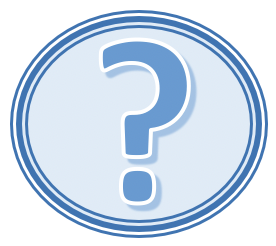
Invest in time PLAYING with questioning
Developing probing inquiry questions which will lead students to deep understanding is hard work; however if learners are given lots and lots of opportunities to develop their questioning skills the task is not so daunting. Give learners time to play with questions so that questioning becomes a natural approach to learning for them. Following are a few ideas to get you started:
- Many games depend on questioning skills like 20 Questions and Jeopardy – be creative, utilize technology and have fun
- Invite students to design review quizzes, surveys, and riddles (harder than you might think) and question of the day for others to ponder.
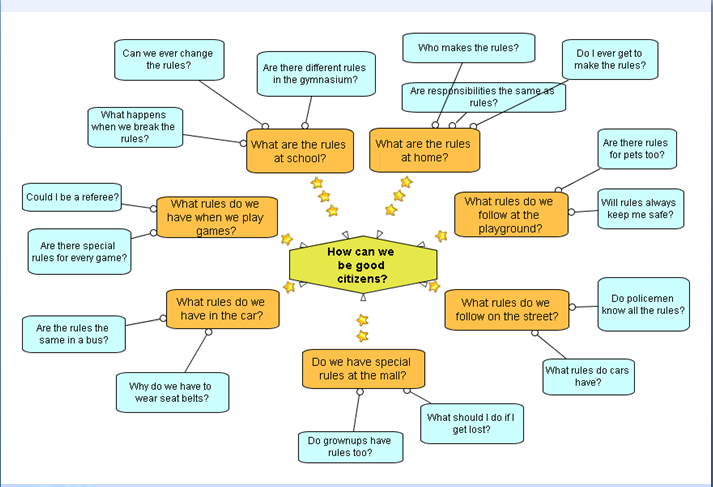
- Brainstorm questions – be creative, utilize collaborative technology tools and experiment – try Q Storming, an exercise where students work in a small group to expand a topic with questions about questions.
- Keep on spinning out questions with the Q-Wheel, available from The Library Marketplace. (For bulk pricing information contact Emily Bradley, Library Marketplace Coordinator Office: 416.363.3388 / Toll free 866.873.9867 – ext. 228.)
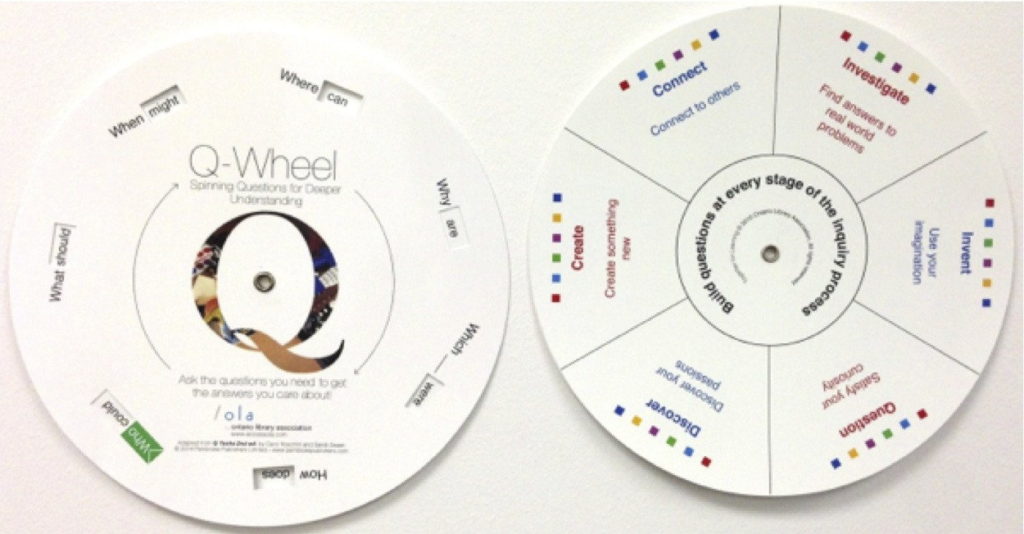
Q-Wheels in Action
Building Questions to Expand a Topic
A teacher-librarian demonstrates the use of a Q-Wheel to formulate good questions with grade one and two students.
Build Imagination and Prediction Skills with Picture Books
Provide each small group of students with a picture book. Ask them to read the title, author, and illustrator and study the visual cover. Ask students to think about the possible story within the covers and spin the Q-Wheel to build questions they are curious about, based on their examination of the cover. The activity could be used just as a pre-reading catalyst with several picture books or students could continue questioning during the story and even after reading to review the story-line or to create ideas for a storybook sequel.
Prepare for Literature and Inquiry Circles
Provide the ‘questioner’ with a Q-Wheel to spin to help with developing questions for a novel study or inquiry topic. The student will need to record the best questions in preparation for the discussion circle.
Deconstruct and Analyze Visual Media
The Q-Wheel is a handy prompt when working with any kind of visual media – photographs, graphs, charts, infographics, advertisements, political cartoons and video etc.. Formally give students lots of experience building questions to help them deconstruct and analyze media. Again working in groups adds to the success. Teach students to consider the type of media, the intended audience, how it was created, special techniques used etc.
Review with Study Buddies
Working with a partner, or in a small group have students review content and quiz each other by building questions with the Q-Wheel.
Note: Students should each handle the Q-Wheel themselves to experience the benefit of having a tangible manipulative to work with. Working in small groups also adds to success as each learner contributes questions and ideas to the collective knowledge building experience. Only one Q-Wheel is needed per group as it is passed to each questioner. Establish some group work protocol such as being encouraging and supportive, all questions are accepted and it is OK to pass if a student cannot come up with a question. The objective is to build experience and confidence creating questions for specific purposes while maintaining a game-like atmosphere.

Collaborate to EXPERIMENT with building questions
When students are just learning how to build effective questions they respond well to working collaboratively. There are many Web 2.0 tools to make collaborations even more powerful. For example build Q-Charts in a Google spreadsheet enables learners to not only work together but also add comments to each other’s questions.
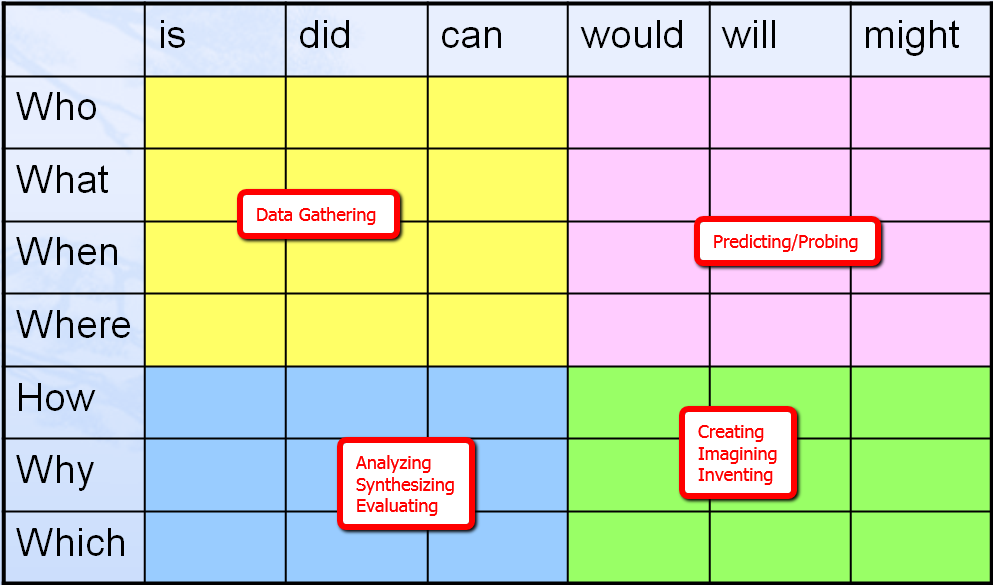
“When we empower students to differentiate between types of questions, they can begin to understand not only how to answer questions but how to create them as well.”
Koechlin & Zwaan 2014, p. 37

Invest TIME to build background and make connections
It is important to equip students with question formulation strategies and techniques. It is also critical to build background on the topic so students have some general knowledge to build on as well as a working vocabulary. It is pretty hard to develop meaningful questions about something you know nothing about. Provide a quick overview or perspective with video resources, newspaper articles, excursion or an expert speaker. Build pathfinders for students to explore best resources and/or encourage students to search and collaboratively curate their own pathfinders.

Design the HOOK
Ignite a desire to learn with a challenge, puzzle, surprise, problem, emotional tug:
- Primary sources such as photographs, film clips, news items, political cartoons, artifacts, story and quotations are proven catalysts for engagement because they are immediate and real.
- Powerful picture books for all ages can be a natural catalyst for questions.
- Technology is an instant motivator and many Ed Tech Tools provide the incentive to question together. Try collaborative brainstorming and mapping and drawing tools as well as creative apps to encourage sharing.
- Celebrate the questions. Just have fun!

Ready for NEXT STEPS
Build Questions at Every Stage of the Inquiry Process (PDF)
References
Koechlin, C., & Zwaan, S. (2008). Building info smarts: how to work with all kinds of information and make it your own. Markham, ON: Pembroke Publishers.
Koechlin, C., & Zwann, S. (2010). Des questions pour apprendre: enseigner aux élèves à se poser des questions et à utiliser adéquatement les réponses. Montréal: Chenelière-éducation. French version of the 2006 edition of Q tasks.
Koechlin, C., & Zwaan, S. (2014). Q tasks: how to empower students to ask questions and care about answers. Markham, ON: Pembroke.
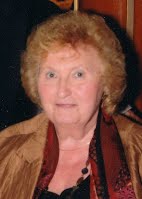
Carol Koechlin is an experienced educator who has contributed to the field of information literacy and school librarianship writing professional books, articles for professional journals, facilitating on-line courses, and presenting workshops in Canada, United States and Australia. Working with Dr. David V. Loertscher, the team has developed foundations for the transformation of school libraries and computer labs into a Physical and Virtual participatory Learning Commons. Explore their work at The School Library Learning Commons – Future Forward. Carol is a founding member of Treasure Mountain Canada (TMC) and has co-chaired TMC Symposiums since 2010. Carol was a contributing writer for Together for Learning: School Libraries and the Emergence of the Learning Commons and writing coordinator for Leading Learning: Standards Of Practice For School Library Learning Commons In Canada (Canadian Library Association, 2014). She is currently a director of Canadian School Libraries (CSL). Carol’s favourite saying, “Empower students to own the question.”